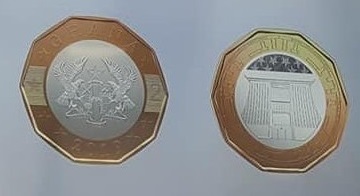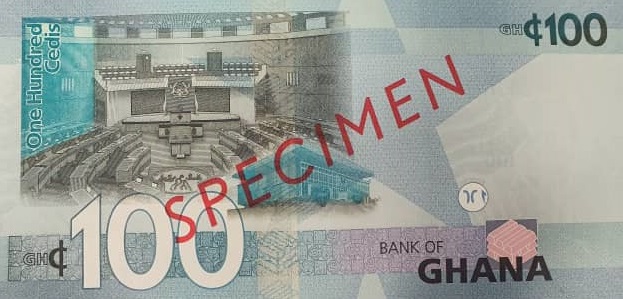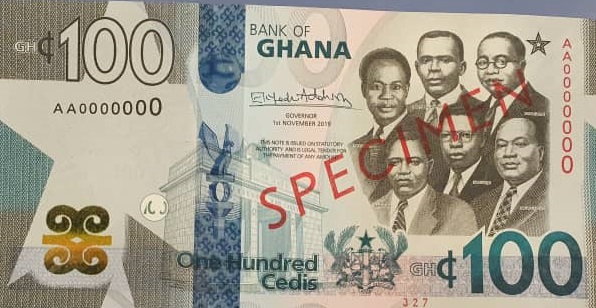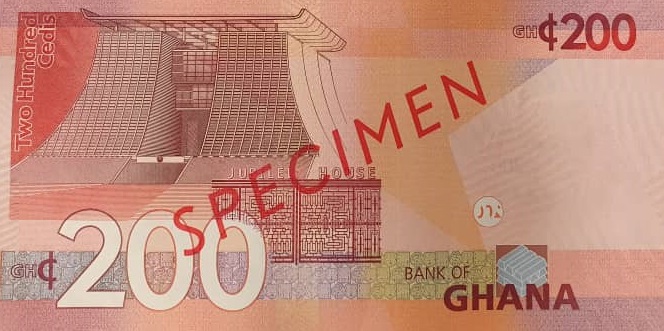The Bank of Ghana (BoG) has announced that it is introducing new high-value denominations of the cedi.
The high-value denominations are GH¢100 and GH¢200 banknotes.
Additionally, Ghana’s central bank is also introducing a new GH¢2 coin.

GH¢2 coin
Design of notes
The general design of both notes follow the style of existing Ghana cedi banknotes.


GH¢100
The colour scheme of GH¢100 note is predominantly grey with turquoise highlights and it has dimensions of 157millimetres x 80 millimetres.
The main image at the back of the GH¢100 banknote is Ghana’s parliament chamber and the secondary image is the parliament building.


GH¢200
The colour scheme of the GH¢200 is predominantly terracotta with red-grey highlights.
The main image at the back of the GH¢200 banknote is the Seat of Government (Jubilee House). The secondary image is part of the fence surrounding the Seat of Government (Jubilee House) building.

PUBLIC SECURITY FEATURES
1. NEW MOTION SURFACE STRIPE (SECURITY THREAD)
It is the wide shiny stripe that runs down the front of the banknote from top to bottom.
2. OPTICALLY VARIABLE MAGNETIC IMAGE (OVMI) – SPARK LIVE
It is a shiny colour changing image of the Adinkra symbols STRENGTH’ on the GH¢100
and ‘ONLY GOD’ on the GH¢200.
When the note is tilted, a shiny bar moves up and down the symbols. The colour changes from Gold to Green when tilted.
3. MORE PROMINENT WATERMARK
It is the image of Tetteh Quarshie with a cocoa pod which has been made more noticeable in
the plain star area of the banknote. It becomes visible on both sides when viewed against light.
The denomination value can also be seen in the watermark.
4. ENHANCED IRIDESCENT BAND AT THE BACK OF THE BANKNOTE
It is a golden bond with gold bars at the back of the banknote that runs from top to bottom. It can be seen more clearly when the note is tilted.
The upper part has a three-dimensional image of an Adinkra symbol moving above an apparently deep background: the symbol of ‘STRENGTH’ on the GH¢100, and ‘ONLY GOD’ symbol on the GH¢200.
The lower part of the stripe features the parliamentary mace on the GH¢100 and state sword on the GH¢200. When tilted these images appear to move.
Questions and Answers by BoG
Introduction of Higher Denomination Banknotes
1. Why has the Bank of Ghana introduced higher denomination?
Answer: High levels of inflation and currency depreciation in the past have eroded some of the gains from redenomination. The deadweight burden, reflected in high transaction cost has re-emerged. This set of higher denominations will address this increased transaction cost, especially in high-valued transactions in a cash based economy. Also, the structure of the banknotes denomination has changed resulting in a shift in demand for higher denominations (GH¢50 and GH¢20 account for about 70% of the total demand), reflecting the expansion in income and prices.
Introduction of the higher value denominations in circulation are therefore necessary to ensure customer convenience, reduction in the costs of printing and other currency management processes.
2. What are the benefits of introducing these higher denominations?
Answer: Ensuring customer convenience; reducing high transaction cost; efficiency in high value transactions in cash; and reduces cost of printing as well as currency management including processing, transporting, and storing banknotes.
3. Will the new higher denomination banknotes lead to higher inflation?
Answer: No. Higher denomination is introduced to only ease high transaction volumes. These notes will only replace some of the large cash transactions done with the existing GH¢50 and GH¢20 banknotes. Again, the value of currency depends on what you can buy with it, rather than what the face value is. Bank of Ghana will remain committed to preserving the purchasing power of the currency.
4. What will happen to the GH¢1 and GH¢ 2 banknotes?
Answer: The GH¢1 and GH¢2 banknotes remain legal tender
5. Will the new higher denomination banknotes also be a transaction note?
Answer: The GH¢100 will complement the existing high denomination banknotes to ease high value transaction. The GH¢200 banknote will be introduced gradually into circulation and will be in limited quantities.
6. Why has the Bank of Ghana introduced GH¢2 coins?
Answer: Bank of Ghana intends to gradually replace its lower banknotes denominations with coins to reduce its cost of printing. BoG will also embark on a vigorous campaign among road transport workers, market operators, small businesses, supermarkets, vendors and others to create avenues for the usage of the coins including develop infrastructures for coin usage.
7. Is the 1Gp still a legal tender?
Answer: The bank has no immediate plan of withdrawing the 1Gp from circulation.
8. How will the Bank of Ghana ensure that Ghanaians are aware of the security features of the new banknotes and coins?
Answer: There will be a nationwide educational campaign focused on the security features, proper handling of banknotes and promote usage of coins.
9. What is the need for higher denominations when other countries are moving towards the paperless mode of payments?
Answer: Introduction of higher denomination banknotes should not be misinterpreted to mean a shift away from the Central Banks policy of pursuing a cashless society and promoting the use of electronic modes of payments. The Bank of Ghana is rigorously pursuing paperless payment systems and recently implemented a regulatory framework for E-Payments and also introduced interoperability. These have enhanced growth in digital payments particularly growth in mobile money transfers and payments. More recently, the Bank announced exploration of issuing Central Bank Digital Currency. While vigorously pursuing financial inclusion by accelerating the migration to e-payment platforms, the bank is mindful of the relevance of cash in our day-to-day dealings. Undeniably, cash still remains the preferred medium of payment by the large informal sector in the country. This is why we continue to pay attention to enhancements in the structure, security features and management of cash within the economy.
BY: graphic.com.gh





























